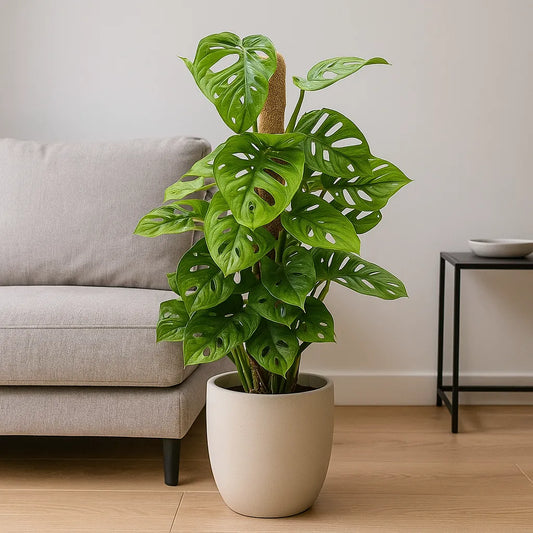A guide to Ficus Elastica Care
The Ficus Elastica or ‘rubber plant’ is a popular, easy to grow, ornamental house plant that brings a tropical feel into your home. This small tree has broad, shiny leaves that grow out long, slender stems that can have a reddish tint. The foliage is a beautiful light-green colour and some varieties will have a copper-red blush underside. The stems themselves can grow between one and two feet tall, which creates height and interest in your room.
What kind of soil does my Ficus Elastica need?
The soil of this Ficus should be well-draining and have a lot of space for air. Look for a good quality Ficus potting soil, and add a small amount of pine bark and perlite to the mix. This will allow the soil to drain well, whilst being loose enough to allow the roots to develop and breathe.
How much light does my Ficus Elastica need?
In the wild the Ficus Elastica will grow under the canopy of larger plants and trees, and has adapted to these conditions. Plant your Ficus in a space that receives bright, but indirect light throughout the day. Remember to rotate your plant by 90 degrees once a week to make sure your plant is getting even sunlight and consistent growth.
How often should I water my Ficus Elastica?
The Ficus Elastica is native to environments that receive rain little and often. This should be how you water your plant, making sure to only water when the top of the soil has become dry to the touch. Ficus plants have a habit of dropping their leaves in the dry season so make sure you are consistent with your watering.
Do I need to fertilize my Ficus Elastica?
You should feed your Ficus Elastica every two weeks in the spring and summer with a diluted liquid fertilizer to maintain healthy growth.
Pruning Ficus Elastica
The Ficus Elastica will benefit from the regular pruning of dead leaves and stems. Pruning is mostly aesthetic here, but should be done to maintain new and healthy growth. If you choose to do a larger pruning of your plant make sure you do so in the spring or summer.
How much humidity and heat does my Ficus Elastica need?
The Ficus should be kept at an ideal temperature between 18 and 21 degrees celsius. They can survive slightly higher temperatures, but will decline quickly in colder temperatures. You should do your best to maintain a constant temperature in your room so avoid placing it near radiators or cold draughts.
The Ficus is a tropical houseplant that is native to the more humid areas on the planet. It has adapted to thrive in high humidity environments so would make an ideal houseplant for the kitchen or bathroom. Low humidity can cause the leaves to shrivel up and drop off. If your plant is not in a naturally humid room you should mist the leaves regularly with water or place your plant on a pebble tray.
What diseases or pests affect Ficus Elastica?
Root rot - root rot is caused when the soil is too wet for a long period of time. The first sign of root rot in your Ficus is that it drops its leaves without any warning. This may be caused by other reasons, so if you suspect root rot you can check by gently listing the plant from the soil to check the roots. Healthy roots are white and stiff, but infected roots will be black, discolored and smell rotten. To fix this issue you will need to prune away any affected roots and repot the plant into new soil. If you catch the problem in time it is easy to fix, but may cause some stress to your plant.
Fungal disease - The Ficus is prone to fungal infections and diseases when being pruned. You will first notice this as white, sometimes hairy, spots on the stems. To solve this issue you should immediately remove any part of the plant that has been affected with sterilized shears. If the disease continues to spread you may have to spray your plant with a houseplant friendly fungicide.
White fly - Whiteflies are sap-drinking flies that infest the leaves of plants. They are easily identified as they will climb over and lay their eggs on the leaves. If not dealt with, these plants can quickly slow down the growth of your plant and cause damage to the leaves. To remove a whitefly infestation, spray the plant with water or a houseplant friendly insecticide until they disappear.
How often should I repot my Ficus Elastica?
If given good growing conditions, the Ficus is a fast-growing houseplant that will outgrow its pot quicker than some other plants. On average you will need to repot your Ficus every two to three years when your pot grows too small for your plant. You can tell that your plant has outgrown its pot when its growth slows. Choose a pot that is one to two inches wider than your current one.
Fill the bottom of the new pot with soil with a small mound in the middle. Remove the Ficus from the old pot and loosen the soil around the roots. Place the plant in the new pot with the roots down the side of the mound. Pack new soil around the roots and water the plant well. In the first few weeks after repotting, the plant may droop slightly as it gets used to its new environment.











Leave a comment
Please note, comments need to be approved before they are published.